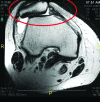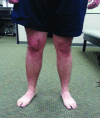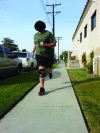Rehabilitation of a 23-year-old male after right knee arthroscopy and open reconstruction of the medial patellofemoral ligament with a tibialis anterior allograft: a case report
- PMID: 24790782
- PMCID: PMC4004126
Rehabilitation of a 23-year-old male after right knee arthroscopy and open reconstruction of the medial patellofemoral ligament with a tibialis anterior allograft: a case report
Abstract
Background: Patellar dislocations are traumatic injuries that occur most often in individuals under the age of twenty and are related to sports and physical activity. Currently, there are no published reports describing the rehabilitation of younger males after arthroscopy and open reconstruction of the medial patellofemoral ligament (MPFL) using a tibialis anterior allograft.
Case description: The subject of this case report was a 23 year-old recreational male athlete who underwent right knee arthroscopic patellar chondroplasty, lateral retinacular release, partial lateral menisectomy, and an open MPFL reconstruction with a tibialis anterior allograft after sustaining a second patellar dislocation. The purpose of this case report is to present the functional outcomes as well as the rehabilitation strategy used during the treatment of this athlete.
Outcome: The patient returned to his prior level of activity after finishing 22 weeks of physical therapy. At a one-year follow-up, the patient reported pain-free physical activity including weight training, running, and recreational basketball.
Discussion: The results of this four-phase rehabilitation program with this subject were excellent. However, research beyond single subject case reports on post-operative rehabilitation for knee arthroscopy and open MPFL reconstruction with a tibialis anterior allograft is lacking. This is the first report that describes a rehabilitation strategy for this procedure. Although there was a successful rehabilitation outcome, future research is necessary to establish optimal rehabilitation guidelines as well as normative milestones for individuals who undergo this surgery.
Level of evidence: 4-Case Report.
Keywords: Patellofemoral; instability; ligament; dislocation; rehabilitation.
Figures
Similar articles
-
[Arthroscopic medial patellofemoral ligament reconstruction combined with lateral retinacular release for recurrent patellar dislocation].Zhongguo Gu Shang. 2015 Jul;28(7):599-602. Zhongguo Gu Shang. 2015. PMID: 26399098 Chinese.
-
Medial Patellofemoral Ligament Injuries in Children With First-Time Lateral Patellar Dislocations: A Magnetic Resonance Imaging and Arthroscopic Study.Am J Sports Med. 2016 Jan;44(1):152-8. doi: 10.1177/0363546515611661. Epub 2015 Nov 24. Am J Sports Med. 2016. PMID: 26602152
-
Functional testing and return to sport following stabilization surgery for recurrent lateral patellar instability in competitive athletes.Knee Surg Sports Traumatol Arthrosc. 2018 Mar;26(3):711-718. doi: 10.1007/s00167-016-4409-2. Epub 2016 Dec 27. Knee Surg Sports Traumatol Arthrosc. 2018. PMID: 28028569
-
Rehabilitation After Medial Patellofemoral Ligament Reconstruction.Sports Med Arthrosc Rev. 2017 Jun;25(2):105-113. doi: 10.1097/JSA.0000000000000147. Sports Med Arthrosc Rev. 2017. PMID: 28459754 Review.
-
Medial patellofemoral ligament reconstruction using an autograft or allograft for patellar dislocation: a systematic review.Knee Surg Relat Res. 2019 Aug 23;31(1):8. doi: 10.1186/s43019-019-0008-0. Knee Surg Relat Res. 2019. PMID: 32660535 Free PMC article. Review.
Cited by
-
Medial Patellofemoral Ligament Reconstruction for Recurrent Patellar Instability Using a Gracilis Autograft without Bone Tunnel.Clin Orthop Surg. 2015 Dec;7(4):457-64. doi: 10.4055/cios.2015.7.4.457. Epub 2015 Nov 13. Clin Orthop Surg. 2015. PMID: 26640628 Free PMC article.
-
Results and Factors Affecting Clinical Efficacy of Medial Patellofemoral Ligament Reconstruction Using a Gracilis Tendon Suture Technique.Clin Orthop Surg. 2022 Sep;14(3):386-392. doi: 10.4055/cios21093. Epub 2022 Jun 30. Clin Orthop Surg. 2022. PMID: 36061836 Free PMC article.
-
REHABILITATION FOLLOWING MEDIAL PATELLOFEMORAL LIGAMENT RECONSTRUCTION FOR PATELLAR INSTABILITY.Int J Sports Phys Ther. 2017 Jun;12(3):494-511. Int J Sports Phys Ther. 2017. PMID: 28593102 Free PMC article.
References
-
- Panni AS Vasso M Cerciello S Acute patellar dislocation. What to do? Knee Surg Sports Traumatol Arthrosc. 2013;21(2):275‐8 - PubMed
-
- Waterman BR Belmont PJ Jr. Owens BD Patellar dislocation in the United States: role of sex, age, race, and athletic participation. J Knee Surg.2012;25(1):51‐57 - PubMed
-
- Elias DA White LM Fithian DC Acute lateral patellar dislocation at MR imaging: injury patterns of medial patellar soft‐tissue restraints and osteochondral injuries of the inferomedial patella. Radiology. 2002;225(3):736‐743 - PubMed
-
- Sillanpaa PJ Peltola E Mattila VM, et al. Femoral avulsion of the medial patellofemoral ligament after primary traumatic patellar dislocation predicts subsequent instability in men: a mean 7‐year nonoperative follow‐up study. Am J Sports Med. 2009;37(8):1513‐1521 - PubMed
-
- Stefancin JJ Parker RD First‐time traumatic patellar dislocation: a systematic review. Clin Orthop Relat Res. 2007;455:93‐101 - PubMed
LinkOut - more resources
Full Text Sources
Research Materials




